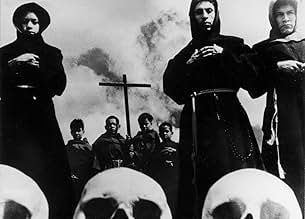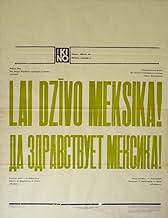IMDb RATING
7.4/10
2K
YOUR RATING
Eisenstein shows us Mexico in this movie, its history and its culture. He believes, that Mexico can become a modern state.Eisenstein shows us Mexico in this movie, its history and its culture. He believes, that Mexico can become a modern state.Eisenstein shows us Mexico in this movie, its history and its culture. He believes, that Mexico can become a modern state.
- Director
- Writers
- Stars
- Awards
- 1 win total
- Director
- Writers
- All cast & crew
- Production, box office & more at IMDbPro
Featured reviews
Film buffs know the history of this lost all too well- Eisenstein came to Hollywood to work for Paramount, Paramount and Sergei never really saw eye to eye. Before giving up on making an American Production, Upton Sinclair invited Eisenstein to make a feature film about Mexico. Eisenstein shot miles of footage, and the money and interest from backers ran out. Eisenstein was forced to return to his native Russia without his Mexican footage. The footage was cut together by others at about this time to make THUNDER OVER MEXICO, and they did not follow Eisenstein's editing notes (They simply made an edit every four seconds. Watch the film and count, you'll see what I mean...) This version, completed by his associates 30 years after his 1948 death comes close to Eisenstein's intent, but without Eisensetin at the editing board, something is missing.
This resulting video is entralling. His incredible shot compositions (which influence me to no end as a film-maker) are all there. There's one scene, which involves a shoot-out reminds us what a John Wayne western directed by Eisenstein would of lookied like.
This resulting video is entralling. His incredible shot compositions (which influence me to no end as a film-maker) are all there. There's one scene, which involves a shoot-out reminds us what a John Wayne western directed by Eisenstein would of lookied like.
This is the greatest documentary fiction I've ever seen, despite this movie was incomplete the beauty of the images is great, with a great culture you can make magic with the camera. The Mexican people have a wonderful big culture and personally I didn't know a little things about my own country.
About the part of fiction is great that this reality is happening know and the sense of revolution is present, i think that only a Russian could understand the sense of the work people.
The drama and the courage of the indians in the defense of the honor and the repression is a symbol of the revolution that needs the country.
About the part of fiction is great that this reality is happening know and the sense of revolution is present, i think that only a Russian could understand the sense of the work people.
The drama and the courage of the indians in the defense of the honor and the repression is a symbol of the revolution that needs the country.
If you know about Sergei Eisenstein's "Que Viva Mexico! - Da zdravstvuyet Meksika!", you probably know that Eisenstein ran out of money and left the movie incomplete, so collaborator Grigoriy Aleksandrov organized the footage as close to how Eisenstein envisioned it. I personally thought that it was a fascinating movie, but one of many films where they throw so much at you that it's really hard to digest.
Knowing that Eisenstein met with the execs at Paramount Pictures but didn't see eye to eye with them, I get the feeling that he may have made this movie in part to indict US involvement in Latin America. As we Americans were supposed to view our southern neighbor as the land of sombreros and senoritas, he wanted to show that there was a more serious-intellectual side, and of course the indigenous aspect.
In my opinion, the combination of the Day of the Dead sequence and the rebellion at the end really constitute the movie's strength, sort of like the rebellion in "Battleship Potemkin". Much of the rest of the film consists of very exaggerated facial expressions (the Russians love those, don't they?). But either way, I still recommend the movie as an important installation in cinematic history, exactly the sort of thing to show in film classes. If anything surprised me, it was that they were allowed to show nudity; I always sort of assume that no major movie in any country was allowed to back then (but don't get me wrong: some of those women were really hot!).
Knowing that Eisenstein met with the execs at Paramount Pictures but didn't see eye to eye with them, I get the feeling that he may have made this movie in part to indict US involvement in Latin America. As we Americans were supposed to view our southern neighbor as the land of sombreros and senoritas, he wanted to show that there was a more serious-intellectual side, and of course the indigenous aspect.
In my opinion, the combination of the Day of the Dead sequence and the rebellion at the end really constitute the movie's strength, sort of like the rebellion in "Battleship Potemkin". Much of the rest of the film consists of very exaggerated facial expressions (the Russians love those, don't they?). But either way, I still recommend the movie as an important installation in cinematic history, exactly the sort of thing to show in film classes. If anything surprised me, it was that they were allowed to show nudity; I always sort of assume that no major movie in any country was allowed to back then (but don't get me wrong: some of those women were really hot!).
It's unbelievable how everything can be art when you look through the eyes of a genius. Sergei Eisenstein: the master of editing, the great father of Russian cinema, a role model for other famous directors like Charlie Chaplin or Andrei Tarkovski; author of cinematic masterpieces like Battleship Potemkin, Ivan the Terrible and Alexander Nevsky. Now we have his version of his Mexican adventure: "Que Viva Mexico!" an epic semi-documentary lost in time. Why was it lost in time for decades? Because no one in Russia or in the USA trusted this film enough to show it. Eisenstein was a nobody when he arrived in the USA to plan another project, the soviet authorities didn't want him in the USSR due to his polemic point of views of the October Revolution and the czarism. Sergei adored Mexico because of its beauty and its hospitality. Famous Mexican painters like Diego Rivera, Frida Kahlo and David Alfaro Siqueiros, along with his Russian partner Trotsky, helped him to inspire. Eisenstein filmed his version of the Mexican traditions and he was very close. As a Mexican, I didn't realized how magical these traditions were until I watched this film. A really good film maker knows how to show the real life in a fantastic way. Now, do I have to say the name of this really good film maker? I don't think so, I think you already know. "Que Viva Mexico!" highly recommendable, Mexican fellows: watch it, this is your real country.
The general plan of this film is strongly reminiscent of two films that Walt Disney made at the request of the State Department during World War II, namely SALUDOS AMIGOS and THE THREE CABALLEROS. The content here is serious and dramatic, the Disney approach is funny entertainment in cartoon form, but similarities are unmistakable.
It is also my understanding that the U.S. State Department sent Orson Welles to Brazil to make a film. Reels and Reels of film were shot, the funding fathers were not given progress reports that convinced them that anything like they wanted would ever result, and the funding was cut off. The fate of the reels and reels of Welles shot film seems quite similar to what happened to Que Viva Mexico.
As a personal evaluation and comment, I would like to add to what others have written, that I saw nothing in this film that could possibly be construed as blatant propaganda. Great films like CASABLANCA and GONE WITH THE WIND have a strong propaganda element to them, the first one, wartime "Us are Good Guys, Nazis are Bad" and the second one "Slavery and the Ku Klux Klan were the good guys, Dixie and the Old South were just wonderful". QUE VIVA Mexico has less propaganda.
It is also my understanding that the U.S. State Department sent Orson Welles to Brazil to make a film. Reels and Reels of film were shot, the funding fathers were not given progress reports that convinced them that anything like they wanted would ever result, and the funding was cut off. The fate of the reels and reels of Welles shot film seems quite similar to what happened to Que Viva Mexico.
As a personal evaluation and comment, I would like to add to what others have written, that I saw nothing in this film that could possibly be construed as blatant propaganda. Great films like CASABLANCA and GONE WITH THE WIND have a strong propaganda element to them, the first one, wartime "Us are Good Guys, Nazis are Bad" and the second one "Slavery and the Ku Klux Klan were the good guys, Dixie and the Old South were just wonderful". QUE VIVA Mexico has less propaganda.
Did you know
- TriviaItalian censorship visa # 75561 delivered on 25 September 1980.
- GoofsThe rifles Sebastian and his friends take from the gallery are of lever-action design, in the following gun-fight in the cactus fields they unmistakably use single-shot bolt-action rifles.
- ConnectionsEdited from ¡Que viva Mexico! (1932)
- How long is Que Viva Mexico?Powered by Alexa
Details
- Release date
- Country of origin
- Language
- Also known as
- ¡Que viva Mexico!
- Filming locations
- Production company
- See more company credits at IMDbPro
- Runtime
- 1h 30m(90 min)
- Color
- Sound mix
- Aspect ratio
- 1.37 : 1
Contribute to this page
Suggest an edit or add missing content





















